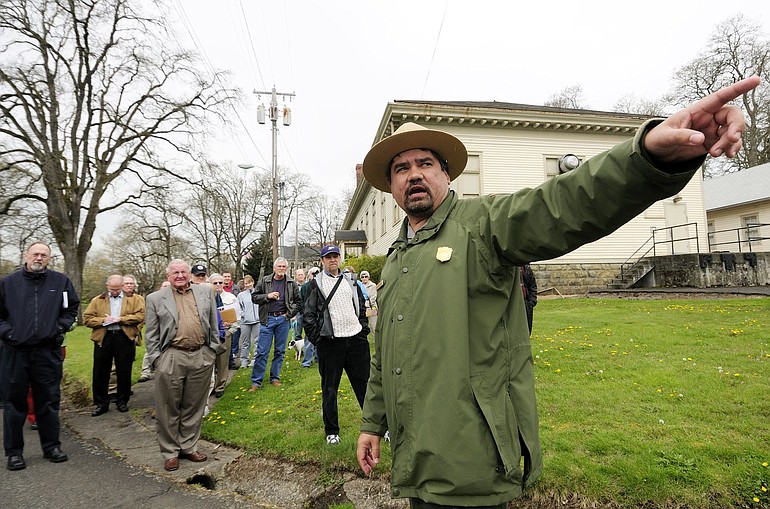About 30 buildings that make up the east and south Vancouver Barracks were constructed between 1903 and 1990.
For 160 years, an Army installation just north of the Columbia River has influenced the future of Vancouver.
Now local residents will get a chance to influence the future of the Vancouver Barracks.
The U.S. Army is handing off its east and south Vancouver Barracks to the National Park Service. On Wednesday afternoon, more than 60 people attended an open house to hear some broad-brush updates from park officials, then walk through one of the Pacific Northwest’s most historic properties.
Bob Cromwell, National Park Service archaeologist, led the tour past Army facilities that haven’t changed much since the early 1900s.
“Remove these vehicles, and you’d be seeing the same thing soldiers saw during World War I,” Cromwell said when the group stopped in a parking lot between buildings.
But it’s not just the structures that reflect local history. Echoes of other historical eras were growing around them, Cromwell observed — and rested beneath their feet.
Nearby Oregon oak trees actually are links to a couple of different chapters of history, Cromwell said.
“There is archaeological evidence that this area was seasonally burned by Native Americans,” Cromwell said. “Oak trees love fire. These oaks are descendants of more than 1,000 years of oaks that have lived in this area.”
They’re also represented in one of the earliest written descriptions of this area.
“In November 1805, Lewis and Clark noted an open prairie with an oak grove. This is the only place that meets that description,” Cromwell said.
A link to the next transitional period wasn’t far away. Hundreds of employees of the Hudson’s Bay Company were buried in a nearby cemetery.
“We’re in it,” Cromwell said.
Actually, there’s a lot more history to the place than meets the eye.
“The Army made maps almost every decade,” Cromwell said. “We’re inheriting 30 buildings. But archaeologically, we’re inheriting another 80 with an archaeological footprint.” Though no longer visible, some of the original foundations remain underground.
Those are just some of the factors that will be in play as the National Park Service moves forward on its master plan. Officials also will consider comments posted at Wednesday afternoon’s open house and a similar meeting Wednesday night.
“We’re just here to listen,” said Tom Gibney, a Park Service landscape architect. “From what people are saying, there is a lot of support to preserve (the barracks site) and put it to good use.”
Patrick Hogan is putting part of it to good use now, as a member of the Fort Vancouver Pipe Band.
“We practice in the band building,” Hogan said. “We would like to continue.”
If portions of the Barracks site change hands and turn into fee-for-use facilities, “Some buildings will get very expensive,” Hogan said. “Let’s look for complementary relationships.”
The preservation issue resonated with Jonathan Frederick, who played his own role in Vancouver Barracks history. Century-old buildings require significant upgrades, said the retired Army colonel, who was senior adviser to the Vancouver Barracks commander in 1991-93.
If you can’t preserve all of the 100-year-old buildings, you can still maintain the character of the original structures, Frederick said. He added the U.S. Military Academy is a good example: “West Point has been rebuilt several times.”
During a recent makeover there, some three-story buildings were replaced by six-story versions.
“The character was such that graduates would come back and say, ‘They haven’t changed a thing.’”
Online comments accepted
The Park Service is taking public comments through May 1 at http://parkplanning.nps.gov/fova. The Park Service hopes to have the plan completed when the last of the Army leaves in the fall of 2011.
Details of who will manage the property are still being worked out. The federal agency is considering an arrangement similar to that between the city of Vancouver and the nonprofit Fort Vancouver National Trust. The city owns Officers Row and the west barracks, where Wednesday’s meetings were held in the former Red Cross Building; the trust manages the properties and land.



